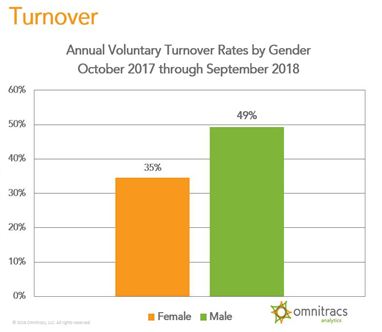
November 15, 2018
By: EMILIE WORSHAM
BUSINESS SYSTEMS ANALYST
Do you believe in furthering gender diversity in the trucking industry? If so, then you likely share the same passion as the 500+ attendees who participated in Women in Trucking’s Accelerate! Conference & Expo this week. I had the honor of presenting at the event and speaking to industry leaders from trucking companies, manufacturers, retailers, and driving schools who believe gender balance is needed for the industry to succeed in the future. These company leaders seem hungry for data, but are either unsure how to get their hands on it or need assistance in interpretation.
My presentation specifically focused on the data behind gender disparity and how there are major misconceptions about a woman’s role in trucking that need to be broken down. For instance, did you know there are just 67 companies that employ only women drivers and only 60 percent of trucking companies employ women drivers as a whole? Additionally, Omnitracs data shows that women drivers make up just nine percent of the trucking workforce. The reason this is so concerning is because women have all the right qualities for the job — they tend to stick with a company for longer, have a smaller percentage of preventable accidents, drive more miles, and have lower dwell time.
Let’s take a closer look at the four ways women are currently prevailing in the trucking industry:
-
Lower Turnover: Data shows that women drivers tend to stick with a company longer. For organizations looking to retain top talent, women just might be the answer. Especially given the fact that the American Trucking Associations (ATA) reported that turnover rates at large truckload carriers rose to 94 percent in Q1 2018, with turnover rates at smaller truckload carriers coming in at 73 percent. Omnitracs data shows that male turnover rates were 69 percent in 2017 compared to 65 percent for women. When it comes to voluntary turnover rates for the last year, men came in at 49 percent and women came in at 35 percent.
- Fewer Preventable Accidents: In the same timeframe mentioned above, there were only two months in which female truck drivers had more severe accidents than men. Omnitracs data from July, August, and September 2017 show that women truckers have been behind the wheel for less than 0.1 accidents per 100 drivers, while men have doubled that with 0.2 accidents per 100 drivers in the same period. Women also tend to have fewer rollovers and rear-end collisions. It’s clear that trucking companies looking for safe, reliable drivers should pay more attention to recruiting women.
- More Miles Logged: Women are known to consistently drive more miles on average than male truckers. Omnitracs data from 2016 shows that women averaged 52,682 miles per year versus 50,344 miles logged by men. Our data also shows that in October 2016 and May 2017, women averaged more than 7,500 miles per month, an average that men never reached.
- Reduced Dwell Time: It makes sense that since women log more hours, they’re able to reduce dwell time as a result. Dwell time can impact a company’s bottom line because it wastes fuel, delays shipments, and puts driver safety at risk. A report from the U.S. Department of Transportation states that dwell time cost truckers upwards of $1.3 billion in income annually. Stemming from Omnitracs data collected from January 1 through September 30 of 2018, women drivers averaged only 60 hours of dwell time compared to 80 hours for men. That means women are leaving less money on the road and putting more in their pocket.
So, why do only four percent of trucking companies use women in their recruiting ads? It’s time for the trucking industry as a whole to assess the best ways to recruit and retain women drivers, as doing so will boost bottom lines. When asked, the company leaders that I had the pleasure of speaking to cited safety as one of the main reasons that companies have a hard time recruiting women. Another key hurdle is letting women know that becoming a truck driver is a viable option for them. That’s why we’re having conversations around safety and healthy living on the road. From secure sleeping areas to quality foods, we want to enable women to feel safe and position them for success in this industry. One operations manager that I spoke to is working with a coffee shop to put in a “truck friendly” window so that a driver can get hot coffee without leaving their cab. They are also hoping to branch out into healthy road-friendly foods so that drivers can get food without leaving their trucks. That way when it’s time to take their break, they can spend their time enjoying their food and relaxing rather than leaving their truck in search for a good meal.
What is clear from my experience at this conference is that companies are somewhat aware that women are a benefit to their company, but are hungry for more information on how to bring them in. With more data and education, we’re hopeful that the gender gap in the trucking industry will continue to close.
